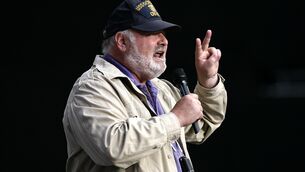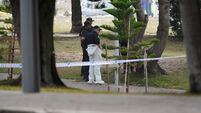Scavengers raid wreckage of crashed Peruvian airliner
Hundreds of scavengers combed through the wreckage of a Peruvian airliner, carrying away scrap metal, passengers’ belongings and electronic equipment that could offer clues into what caused the crash that left at least 37 dead.
But even before an official investigation was under way into the Tuesday crash of the TANS Airline Boeing 737-200, aviation experts were beginning to cast blame on the pilot, saying his extensive background as a fighter pilot may have prompted him to take risks civilian pilots would not consider.
The airline has said wind shear likely forced the emergency landing and that the pilot’s actions saved the lives of at least 58 people on board.
This meant that investigators must probe at least two theories when they take up their task in the Amazon jungle town of Pucallpa, where hundreds of residents, unobstructed by the dozens of air force soldiers at the crash site, dug through the debris yesterday looking for anything of value.
“I’m collecting this for my house to hang my laundry,” said Rosario Dahua, 47, as she tugged at a tangle of heavy black wires next to a partially submerged turbine jet motor wedged in the water and mud.
The airliner was carrying 98 people, including six crew members, on a domestic flight from the Peruvian capital of Lima to Pucallpa when it crash-landed on Tuesday in a marsh a few miles from the Pucallpa airport, said company spokesman Jorge Belevan.
At least 58 people survived the crash that killed at least 33 passengers and four crew members, including the pilot, Octavio Perez Palma.
Belevan said there were 18 foreigners aboard the aircraft – 11 Americans, four Italians, one Colombian, one Australian and one from Spain.
Among the dead were at least five foreigners – an American man and woman, a Spanish woman, an Australian woman and a Colombian woman, officials in Peru said.
Belevan said three missing people might include survivors from Pucallpa who returned to their homes after the crash without receiving medical assistance.
Air Force Cmdr. William Rodriguez, in charge of security at the site, said yesterday he did not believe the people would impede the work of civil aviation investigators who had not yet arrived.
“We are verifying that all the bodies have really been recovered,” Rodriguez said. “So if these people want to search for things, perhaps they’ll encounter another body.”
He said crash investigators recovered the plane’s flight data recorder on Wednesday, but had not yet found the cockpit voice recorder, which he said “is not as important as what they found yesterday.”
But Belevan said later that it was the voice recorder that had been recovered, not the data recorder.
Juan Berte, 33, said he had no idea what function the electronic equipment he was carting away served.
He said he was not concerned about inadvertently removing key evidence.
“Look, we’re taking stuff to keep, perhaps in the house, to look at like a toy,” he said, holding a cracked insert panel with a blue numeric dial.
A warning label on top of the component said: “Electrostatic Sensitive” and “Special handling required.”
Berte also carried another electronic component that said “Sperry Flight Systems.” When a reporter asked to inspect the item, Berte became nervous and ran away.
Hernan Vargas, an aeronautical engineer, yesterday likened removal of parts from the crash site to contaminating a police murder scene.
“There has been much manipulation of the disaster site since even yesterday, and we have been able to see in the images that they are moving parts (of the plane),” he told Channel 5 television.
That may be the reason the “black box” had not been found yet, he said.
TANS, an air force-operated airline that provides service to the jungle, in some cases to areas where commercial airlines don’t fly, is a money-loser.
It has faced criticism in the local media for paying below-industry level wages to its mechanics and technicians who maintain its fleet of ageing planes.
Belevan said the aircraft that crashed was leased and was built in 1983.
Perez Palma began his approach to the airport in torrential rains and strong winds, which passengers said began rocking the plane. About four miles from the airstrip he attempted to make an emergency landing, TANS said.
He apparently aimed for the marsh to soften the impact, but the aircraft broke apart in the landing, strewing pieces of fuselage as it skidded over the boggy ground.














